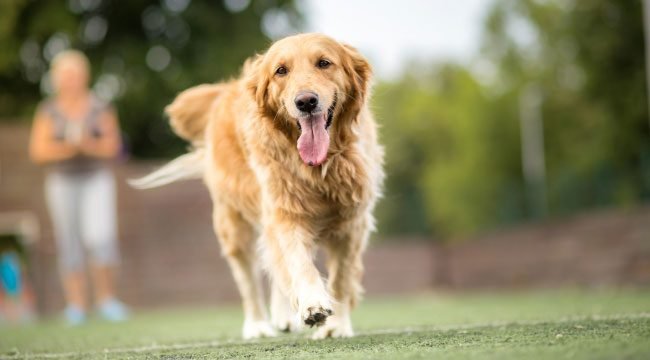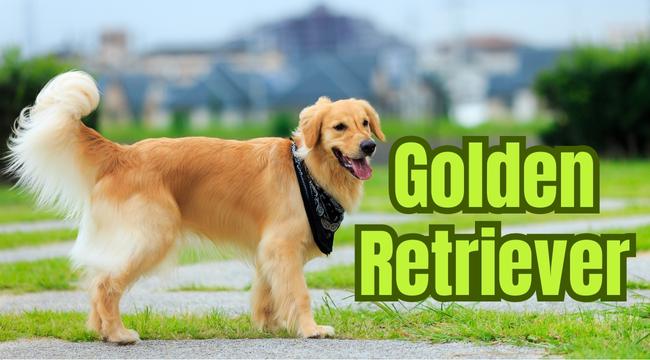Golden Retrievers are a popular breed of dogs known for their charming personalities, playful nature, and adorable looks. These dogs have long, shiny coats that come in shades of gold, which is why they are called Golden Retrievers.
However, if you have come across the term “English Cream Golden Retriever,” you might be wondering what makes them different from the standard Golden Retrievers that are commonly seen in America.
While they may appear to be the same breed with a different coat color, there are some differences that set them apart. In this article, we will delve into the world of English Cream Golden Retrievers and discover what makes them unique.
More Information About Golden Retrievers

Golden Retrievers are a popular dog breed in the United States, and for good reason. They are highly intelligent, sociable, beautiful, and loyal companions. However, they also have a lively personality and are slow to mature, often retaining their playful and silly traits until three or four years of age, and sometimes even into old age. Originally bred for retrieving ducks and other fowl for hunters, they require daily exercise such as a walk, jog, run at the beach or lake (they love water), or a game of fetch. Additionally, they need a job to do, whether it’s retrieving the paper, waking up family members, or competing in dog sports. A well-exercised Golden is a well-behaved one. It’s important to note that Golden Retrievers are family dogs and need to be with their “pack.” They thrive when they are included in family activities and kept in the house with their family. While they may bark at strangers, they are not watchdogs and are more likely to wag their tail and flash their characteristic Golden smile.
Breed Overview
Golden Retrievers are known to shed quite a bit, especially during spring and fall seasons. Regularly brushing your Golden can help reduce the amount of loose hair on their coat, preventing it from spreading all over your home and clothing. However, if you share your life with a Golden Retriever, it’s best to accept that some level of dog hair is inevitable.
These dogs are great family pets and enjoy being a part of their human “pack.” They thrive when living indoors with their family and should not be left alone in the backyard for extended periods of time.
Golden Retrievers are active dogs and require at least 40-60 minutes of daily exercise. Engaging them in activities such as obedience training, agility classes, and other canine sports can provide them with both physical and mental stimulation.
Despite their gentle nature, Golden Retrievers can be quite boisterous and are large dogs that may accidentally knock over small children. They are great with kids but should be supervised around them.
It’s important to monitor your Golden’s diet as they love to eat and can quickly become overweight if overfed. Feeding them measured amounts of kibble in regular meals and limiting treats can help maintain a healthy weight.
Unfortunately, the popularity of Golden Retrievers has led to irresponsible breeding practices, with many breeders prioritizing profit over the health and well-being of the dogs. It’s crucial to find a reputable breeder who tests their breeding dogs for genetic diseases and has sound temperaments. Avoid buying puppies from puppy mills, pet stores, or irresponsible breeders to ensure that you bring home a happy and healthy companion.
Appearance

Golden Retrievers are beautiful dogs that possess a distinctive appearance. Adult males of this breed typically weigh between 65 to 75 pounds, while females weigh between 55 to 65 pounds. Their coloring ranges from light golden to cream, and dark golden to golden, creating a stunning coat that catches the eye.
Their physique can vary from broad and dense to leaner and more sporty. However, according to the American Kennel Club (AKC) standards, Golden Retrievers should move with a smooth and powerful gait. Their feathery tail is carried with a “merry action,” as breed fanciers say, which is a distinctive feature of the breed.
Golden Retrievers are known to shed often and a lot, so they require regular brushing to maintain their beautiful coat. Due to their breeding as hunting and waterfowl-retrieving dogs in the Scottish Highlands, their outer coat is dense and repels water, which makes them perfect for those activities. They also have a thick undercoat that adds to their overall density. Their coats can vary in texture from wavy to straight, and they have heavy feathering on their chest, the backs of their legs, and their tail.
In summary, Golden Retrievers are stunning dogs that possess a beautiful coat, a distinctive feathered tail, and a smooth and powerful gait. They require regular grooming due to their shedding and have a dense outer coat that repels water, making them a great choice for outdoor activities.
History
The history of the Golden Retriever breed is rich and fascinating. There was once a popular legend that claimed these dogs were descended from Russian circus sheepdogs, but the truth is even more interesting. In reality, the breed was developed by a Scottish nobleman named Sir Dudley Majoribanks, who later became known as Lord Tweedmouth.
Tweedmouth was an animal enthusiast and a passionate hunter of waterfowl. He aimed to create a retriever with a superb nose and a talent for retrieving that would be more responsive to human hunting companions than the spaniels and setters that were popular at the time. He also wanted the dog to be loyal and even-tempered in the home. In pursuit of his vision, he bred his dog, Nous, to a Tweed Water Spaniel named Belle, who was known for her exceptional calmness and loyalty.
The resulting puppies were then bred with other dogs, including Wavy- and Flat-coated retrievers, another Tweed Water Spaniel, and a red setter. Tweedmouth selected mostly yellow puppies to continue his breeding program and gave others to his friends and family. This breeding program resulted in the distinctive Golden Retriever breed that we know and love today.
Golden Retrievers quickly gained fame for their hunting abilities, with one notable example being Don of Gerwyn, a liver-coated descendant of Tweedmouth’s dogs who won the International Gundog League trial in 1904. The breed was officially recognized by the Kennel Club in England as a distinct breed in 1911 and was classified as “Retriever – Yellow or Golden” at that time. In 1920, the breed’s name was officially changed to Golden Retriever.
Golden Retrievers Personality
The Golden Retriever is renowned for its sweet and gentle temperament. Bred specifically to work alongside people, these dogs are incredibly people-oriented and thrive on human interaction. They are eager to please their owners and are known for their loyalty and devotion. However, despite their natural good-naturedness, proper training and socialization are crucial to help them reach their full potential and be well-behaved members of the family.
Early socialization is particularly important for Golden Retrievers. As puppies, they need to be exposed to various people, sights, sounds, and experiences to help them develop into well-rounded dogs. This will help them learn to be comfortable and confident in different situations and environments, making them less likely to develop anxiety or fear later on in life.
Overall, the Golden Retriever’s personality makes them excellent companions for families, children, and seniors alike. They are adaptable and can adjust to various lifestyles, from active outdoor enthusiasts to more laid-back homebodies. With proper care, training, and socialization, these dogs can bring years of joy and companionship to their human families.
Health

Golden Retrievers are one of the most popular dog breeds in the world due to their friendly personalities, loyalty, and intelligence. However, like all breeds, they are prone to certain health conditions. In this article, we will discuss some of the health concerns that you should be aware of if you are considering getting a Golden Retriever, as well as how to prevent and treat them.
Health Clearances
Before buying a Golden Retriever puppy, it is important to find a reputable breeder who will provide health clearances for both parents. These clearances show that the dogs have been tested and cleared of certain hereditary health conditions. In Goldens, you should expect to see health clearances for hip dysplasia, elbow dysplasia, hypothyroidism, von Willebrand’s disease, thrombopathia, and eye disease. You can check the Orthopedic Foundation for Animals (OFA) website for more information.
Hip Dysplasia
Hip dysplasia is a common hereditary condition in which the thighbone does not fit snugly into the hip joint. This can lead to pain and lameness, and as the dog ages, arthritis can develop. X-ray screening can detect hip dysplasia, and dogs with this condition should not be bred.
Elbow Dysplasia
Elbow dysplasia is a hereditary condition that affects large-breed dogs. It is caused by the three bones that make up the dog’s elbow growing at different rates, causing joint laxity and painful lameness. Surgery or medication may be necessary to correct the problem.
Cataracts
Cataracts are cloudy spots that develop on the eye lens, and they can cause vision loss in severe cases. Breeding dogs should be examined by a board-certified veterinary ophthalmologist to be certified as free of hereditary eye disease.
Progressive Retinal Atrophy (PRA)
PRA is a family of eye diseases that causes the gradual deterioration of the retina. Dogs become night-blind in the early stages and lose their daytime vision as the disease progresses. Many dogs adapt well to limited or complete vision loss.
Subvalvular Aortic Stenosis
Subvalvular aortic stenosis is a heart problem that can cause fainting and sudden death. Your vet can detect it and prescribe the proper treatment.
Osteochondrosis Dissecans (OCD)
OCD is an orthopedic condition caused by improper growth of cartilage in the joints. It causes painful stiffening of the joint, and it can be detected in dogs as early as four to nine months of age. Overfeeding or feeding high-protein foods may contribute to its development.
Allergies
Golden Retrievers can be allergic to a variety of substances, ranging from food to pollen. Signs of allergies include excessive licking of paws or rubbing of the face. If your dog exhibits these symptoms, consult your vet.
Von Willebrand’s Disease
Von Willebrand’s disease is an inherited blood disorder that interferes with the blood’s ability to clot. Excessive bleeding after an injury or surgery is the main symptom. There is no cure, and blood transfusion is currently the only treatment. Dogs with this condition should not be bred.
Gastric Dilatation-Volvulus (Bloat)
Bloat is a life-threatening condition that occurs when the stomach fills with gas and twists. This can impede blood flow and cause shock. Symptoms include a distended abdomen, excessive drooling, and retching without throwing up. If you suspect your dog has bloat, seek immediate medical attention.
Epilepsy
Epilepsy is a brain disorder that causes periodic seizures and convulsions. Medication can help manage the condition.
Golden Retrievers care
Golden Retrievers are a high-energy breed that require plenty of exercise and outdoor activity. Owners who enjoy hiking, jogging, or tossing a ball in the backyard will find a perfect companion in a Golden Retriever. These dogs are naturally built for action and love to retrieve, so they are happy when they have something to carry in their mouths.
To keep your Golden Retriever happy and healthy, it is important to provide them with 20-30 minutes of vigorous exercise twice a day. This helps to burn off their excess energy, and keeps them mellow and calm when they are inside. Failing to provide them with adequate exercise can lead to behavior problems.
When raising a Golden Retriever puppy, special care should be taken to ensure that their joints develop properly. Between the ages of four and seven months, these dogs grow very rapidly and are susceptible to bone disorders. It is important to avoid letting them play on hard surfaces such as pavement until they are at least two years old and their joints are fully formed. Puppy agility classes and playing on grass are great alternatives for exercise.
Golden Retrievers are naturally “mouthy” and enjoy carrying things in their mouths. Owners can provide them with soft toys, balls, newspapers, or even smelly socks to carry around. This behavior is normal for retriever breeds, and helps to keep them entertained and happy. By providing adequate exercise and care, Golden Retrievers can be wonderful companions for active individuals and families.
Feeding
Feeding your Golden Retriever properly is essential to maintain their overall health and wellbeing. Here is a guide to feeding your Golden Retriever:
Recommended Daily Amount:
2 to 3 cups of high-quality dry food a day, divided into two meals.
It is important to note that the amount of food your adult dog requires will depend on his size, age, build, metabolism, and activity level. Therefore, it is crucial to pay attention to your dog’s individual needs.
Feeding Schedule:
It is recommended to feed your Golden Retriever twice a day rather than leaving food out all the time. This helps to prevent overeating and maintain a healthy weight.
Maintaining a Healthy Weight:
To keep your Golden Retriever in good shape, it is important to measure his food and monitor his weight. You can do the “eye test” and “hands-on test” to determine if your dog is overweight or not. If you cannot see his waist or ribs, then he may need less food and more exercise.
Puppy Feeding:
If you are raising a Golden Retriever puppy, it is important to provide a high-quality, low-calorie diet to prevent rapid growth, which can lead to bone disorders. Puppies between the ages of four and seven months are particularly susceptible to these disorders.
Feeding Guidelines:
It is important to feed your Golden Retriever a high-quality dog food that is appropriate for their age, weight, and activity level. The better the quality of the food, the more nourishing it will be for your dog, and the less food you will need to feed them.
By following these feeding guidelines, you can ensure that your Golden Retriever stays healthy and happy throughout their life.
Feeding Chart
| Age | Type of Food | Cups a Day | Meals a Day |
| 0 – 30 days | Mother’s Milk | n/a | As needed |
| 4 – 7 weeks | Mother’s Milk | n/a | As needed |
| 8 – 12 weeks | Puppy Kibble | 1 1/2 – 2 | 3 – 4 |
| 12 weeks – 6 months | Puppy Kibble | 2 | 3 |
| 6 – 15 months | Puppy Kibble/Adult Dog Food | 3 – 4 | 3 |
| Adult | Adult Dog Food | 3 – 5 | 2 |
Coat Color And Grooming
Golden Retrievers boast a stunningly beautiful coat, which is both dense and water-repellent, featuring a thick undercoat. The texture of their fur can range from wavy to straight, adding to their individual charm. It’s worth noting that the fur on their front legs’ back and underbelly feathers, with more abundant feathering on their chest, back thighs, and tail, making them all the more magnificent.
When it comes to their coat color, Golden Retrievers exhibit a wide range of hues, from light to dark gold, making each one uniquely gorgeous. Some breeders have attempted to sell white Golden Retrievers, but the American Kennel Club does not accept white as a coat color for the breed.
If you plan to welcome a Golden Retriever into your home, it’s essential to be aware of their shedding patterns. Moderate shedding is typical in the winter and summer months, while they tend to shed heavily in the fall and spring. It’s no secret that living with a Golden Retriever means accepting a certain amount of dog hair on your clothes and around your home.
Given their thick and luscious coat, it’s no surprise that Golden Retrievers require a significant amount of grooming. Daily brushing is crucial in preventing matting, but even once a week is the bare minimum. Additionally, they need to be bathed at least once a month to maintain their clean and fresh-smelling appearance. Of course, more frequent baths may be necessary, depending on the dog’s lifestyle and activity level. By providing the proper grooming regimen, you can help your Golden Retriever look and feel their best. Below, we will provide you with tips and advice on how to groom a Golden Retriever.
1. Bathing Your Golden Retriever
Bathing your Golden Retriever is an important part of their grooming routine. It’s recommended that you bathe your Golden Retriever once every three months or as needed. Here are the steps to follow when bathing your Golden Retriever:
- Brush your dog thoroughly before the bath to remove any tangles or mats.
- Wet your dog’s coat with warm water.
- Apply dog shampoo and work it into a lather.
- Rinse your dog thoroughly with warm water, making sure to remove all the shampoo.
- Towel dry your dog and brush their coat while it’s still damp.
2. Brushing Your Golden Retriever’s Coat
Brushing your Golden Retriever’s coat is essential to keeping it healthy and shiny. It helps remove dead hair, tangles, and mats, and stimulates blood circulation to promote a healthy coat. Here are the steps to follow when brushing your Golden Retriever’s coat:
- Use a slicker brush to remove any tangles or mats.
- Use a pin brush to remove any loose hair and stimulate blood circulation.
- Use a comb to remove any remaining tangles or mats.
3. Trimming Your Golden Retriever’s Nails
Trimming your Golden Retriever’s nails is an important part of their grooming routine. Overgrown nails can cause discomfort and pain for your dog, and can even lead to infection. Here are the steps to follow when trimming your Golden Retriever’s nails:
- Use sharp, high-quality nail clippers.
- Hold your dog’s paw firmly but gently.
- Clip the tip of each nail, being careful not to cut the quick (the pink part inside the nail).
- If you accidentally cut the quick, apply a styptic powder or cornstarch to stop the bleeding.
4. Cleaning Your Golden Retriever’s Ears
Cleaning your Golden Retriever’s ears is important to prevent infections and keep them healthy. Here are the steps to follow when cleaning your Golden Retriever’s ears:
- Use a cotton ball or soft cloth and ear cleaning solution.
- Gently wipe the inside of your dog’s ear, being careful not to go too deep.
- Repeat on the other ear.
Children And Other Pets
The affable nature of Golden Retrievers makes them perfectly suited for living with children and other pets. Their sociable personality allows them to thrive in the company of youngsters and adapt well to a bustling family environment. However, despite their friendly disposition, it’s important to supervise interactions between children and dogs to prevent any accidental injuries. This is especially true with the Golden Retriever, as they are a large and strong breed that can easily knock over small children.
It’s essential to teach children how to approach and handle dogs gently, and to never disturb them while they’re sleeping or eating. Additionally, it’s crucial to never leave any dog unsupervised with a child, no matter how docile the dog may seem.
When it comes to other pets, Golden Retrievers are just as welcoming. They thrive on companionship and are known to get along with other dogs, cats, rabbits, and other animals, provided they receive proper introductions and training. With some patience and training, Golden Retrievers can coexist peacefully with almost any other animal in the household.

